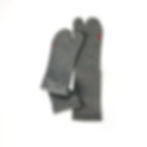
Ta Bi 足袋
When I told local Japanese that foreigners called tabi socks "ninja socks", most of them grinned and asked, "Really? Why Ninjas? We all wear tabi."
I have no idea, perhaps it was attributed to movies, anime or the tourist souvenir shops in Asakusa selling tabi socks alongside with Ninja costumes and toys.
TA-BI literally translates as "foot bags". And not only on special occasions when tabi goes with formal kimono attire; Tabi socks are also worn daily by many, including my chiropractor, my ceramics sensei, and others such as construction workers and craftspersons where extend standing and moving around are their daily norm.

Japanese Traditional Tabi
Tabi socks existed in Japan since mid 700 A.D. as a foot-garment worn with split-toe clogs called geta. Tabi was a luxury, and was available only to the elite and samurais then. They were worn only on special occasions with permission.
It was not until the 1600s that tabi became available to commoners. Special artisans "Tabi-shi" 足袋師 set up shops making and selling them. From trimming to sewing, there are 13 tailoring steps in making traditional tabi-socks. It remained a slow-craft even when the production was industrialized in the late 1800s. However, in Post-war Japan, western-style fashion (and socks) became popular and took over the market.
Today, Tabi remains indispensable. Though there are few remaining Tabi specialty shops in Japan still producing traditional hand-sewn socks. These non-stretchable traditional foot bags are still being worn in formal occasions like tea ceremonies or traditional festivals.
Photo courtesy: Japan National Diet library. Merchants and Livelihood of Edo Period. Volume 6 (1690).
Toes, liberated.

Tabi remains indispensable not only because of kimono and traditional rituals, but because of its benefits.
Cold Feet?
It is commonly believed that tabi socks encourage blood circulation, reduce stress on the back and improve posture.
Tactility, down there.
The ability for the toe to feel and naturally grasp the ground better keeps you in good balance and reduces fatigue. No wonder why ninjas and construction guys love them as they probably climb and walk the roof often. Joggers and hikers are fans of tabi, too.
Snug fit
Frustrated over socks that become loose after a few washes and keep sliding off? Tabi doesn't go any where.
Tabi Crew Socks
Fall in love with Amitabi. Made by people dedicated to sustaining and reinventing sock-making.


Deep-dive into Japan's World of Socks
TAIKO is a family-owned socks manufacturer established over 70 years ago in Nagano, a town historically known for its silk yarn, textile and socks industry. The company has remain dedicated in quality and development over mass production, which allows them to produce small quantity but high-quality performance products loved by professional athletes and outdoor and sports enthusiasts.
AMITABI is one of Taiko's latest development when the 4th generation succeeded the business, he desired to use state-of-the-art knitting technology to reinvent nostalgic tabi socks that is close to the heart (and the feet).

























